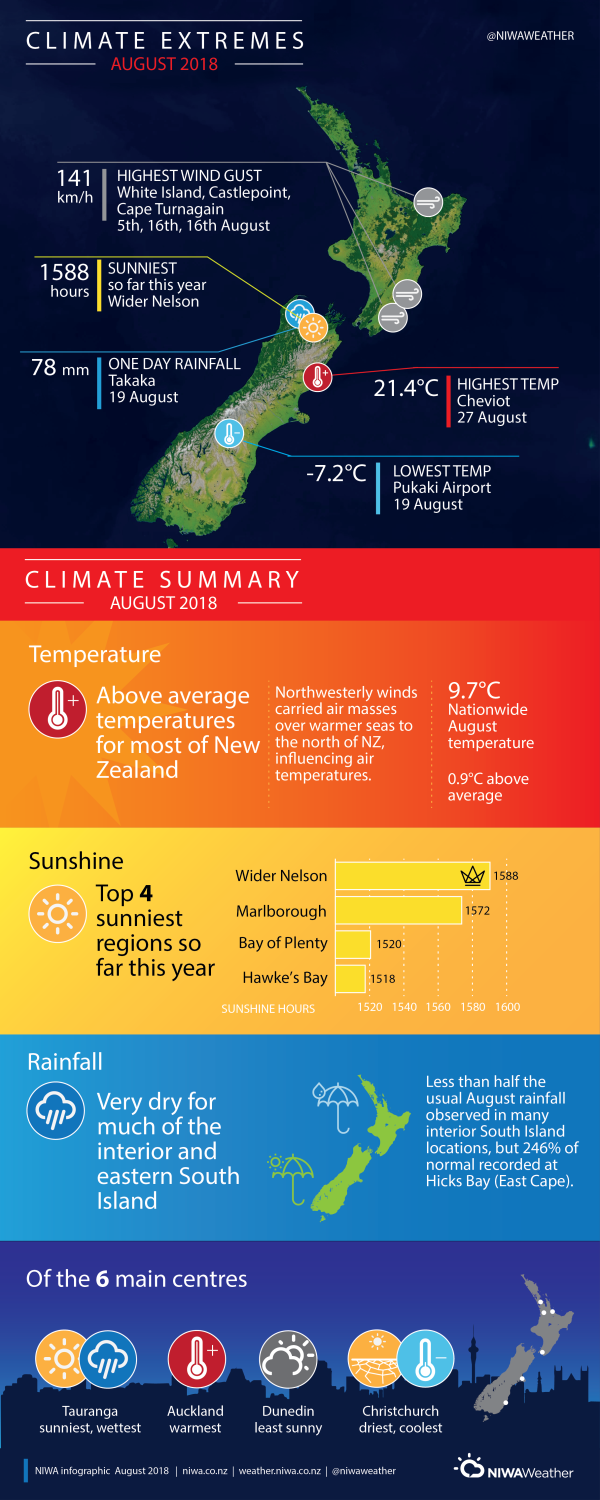A dry end to winter for much of the South Island.
|
Temperature
|
Mean temperatures were above average (+0.51°C to +1.20°C of the August average) for most of New Zealand, particularly the southern half of the North Island and the central and western South Island. Near average temperatures (-0.50°C to +0.50°C of the August average) were observed for most of the eastern South Island and northern and western North Island. |
|
Rainfall |
Rainfall was well below normal (<50% of the August normal) for most of Canterbury and interior Otago. Northland experienced below normal rainfall (50-79% of the August normal). Well above normal rainfall (>149% of the August normal) was observed in the Bay of Plenty and East Cape, as well as Nelson. Parts of Manawatu-Whanganui experienced above normal rainfall (120-149% of normal), and near normal rainfall was observed elsewhere (80-119% of normal). |
|
Soil Moisture |
As of 1 September 2018, soil moisture levels were above normal for the time of year in coastal Otago and Marlborough, as well as around coastal Gisborne. Slightly drier than usual soils were present in southern Hawke’s Bay, north Canterbury, and central Otago. Soil moisture levels were generally near normal for the time of year across the rest of the country. |
Overview
Mean sea level pressure was below normal over and to the southwest of New Zealand during August. This led to more westerly and northwesterly air flows than normal, which helped to keep air temperatures elevated during the month. This pressure setup influenced rainfall totals particularly in the South Island, where much of Canterbury and interior Otago experienced dry conditions for the time of year as these areas were sheltered from the prevailing wind flow by the Southern Alps.
August 2018 was a tale of two islands in terms of rainfall. Most of the central and eastern South Island was very dry for the time of year, with less than half the usual August rainfall observed in many places in Canterbury and Otago. Notably, both Queenstown and Christchurch recorded less than 30% of the normal August rainfall for those locations. In contrast, parts of the North Island observed high rainfall totals, with Hicks Bay (East Cape) experiencing almost two-and-a-half-times its usual August rainfall (246%).
August was a relatively warm month, with above average temperatures (+0.51 to +1.20°C above average) for most of New Zealand. The predominant northwesterly airflows during August carried air masses over warmer seas to the north of the country, influencing air temperatures.
The nationwide average temperature in August 2018 was 9.7°C (0.9°C warmer than the 1981-2010 August average from NIWA’s seven station temperature series which begins in 1909). Based on the seven station series, August 2018 was the ninth-warmest August on record.
Further highlights
- The highest temperature was 21.4°C, observed at Cheviot on 27 August.
- The lowest temperature was -7.2°C, observed at Pukaki Airport on 19 August.
- The highest 1-day rainfall was 78 mm, recorded at Takaka on 19 August.
- The highest wind gust was 141 km/h, observed at Castlepoint on 16 August.
- Of the six main centres in August 2018, Tauranga was the wettest and sunniest, Christchurch was the coolest and driest, Auckland was the warmest, and Dunedin was the least sunny.
- Of the available, regularly reporting sunshine observation sites, the sunniest four regions in 2018 so far (1 January – 31 August) were Wider Nelson (1588 hours), Marlborough (1572 hours), Bay of Plenty (1520 hours) and Hawke’s Bay (1518 hours).
- Of the available, regularly reporting low elevation rainfall sites, the top two wettest locations in 2018 so far (1 January – 31 August) were Milford Sound (5023 mm) and Arthur’s Pass (3364 mm). The top two driest locations in 2018 so far were Alexandra (284 mm) and Eglinton (306 mm).
Download
- August 2018 Climate Summary information [PDF 460KB]
- August 2018 Climate Statistics [PDF 67KB]
Contact
Petra Pearce, Climate Scientist NIWA Auckland.
Tel. 09 375 2052

